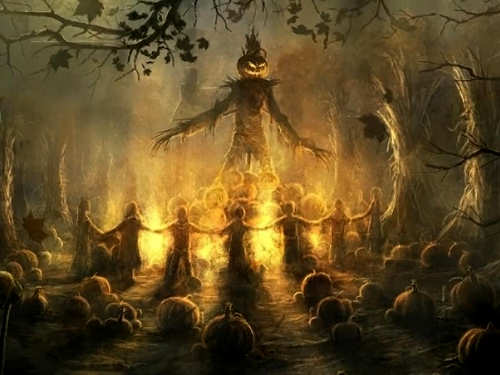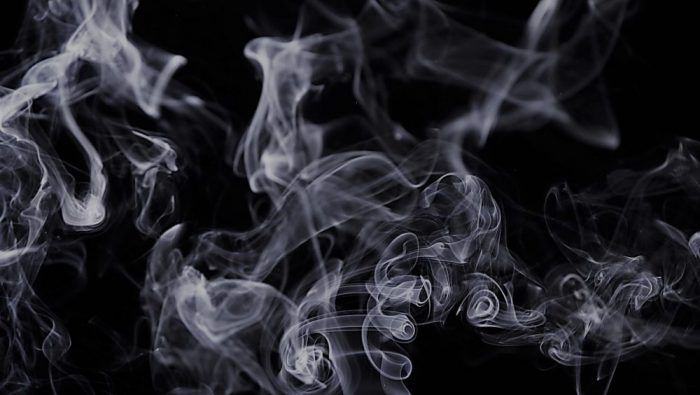Brian McCowan, ERS
Halloween has its roots in the Celtic traditional celebration of Samhain, which first took place during the Iron Age (considered to be about 800 BC to 100 AD) in what is now Ireland and Scotland. Samhain began as a collection of rituals that recognized the end of summer, the completion of crop harvests, and the preparation for winter. During this time period, the Celts divided their calendar into two seasons: Light and Dark. Samhain marked the transition from the Light to the Dark season. Celebrations were three-day long events consisting of bonfires, crop and animal sacrifices in the fires, fortune telling, visits from the dead, and playing tricks on others that were blamed on visiting spirits. Participants often wore masks and costumes to disguise themselves from spirits who may be seeking revenge for earlier misdeeds.
According to the Encyclopedia Britannica, “During Samhain the world of the gods was believed to be made visible to humankind, leading to supernatural tricks and trouble; ghosts of the dead and spirits were thought to return to the earth.” The Roman Catholic Church, seeking to end all Pagan rituals, co-opted Samhain into All Saints Day, also known as All Hallows, and All Hallows Eve eventually begat Halloween.
In 17th century New England, Puritans banned the holiday as they rejected (purified) all celebrations connected with the Catholic Church. But Scottish and Irish emigrants brought their traditions to Canada and the United States as they fled famines and the “Highland Clearances.” Samhain evolved into a secular celebration that carries on many of the Iron Age Celtic traditions.

Energy Efficiency Pioneers Gathered Around the Bonfire
The prospect of bringing back spirts for a day is compelling – hearing their stories, learning some forgotten history, or just letting them enjoy the bonfire for a day would be both a trick and a treat. To hear some authentic stories from pioneers of energy efficiency, we at Zondits would like the following departed souls to join us around the Samhain bonfire:
Lewis Latimer – Some claim that Latimer, a black man, was the real inventor of the electric lightbulb. What is likely more accurate is that both he and Thomas Edison improved upon the electric lightbulb that was being worked on by many inventors at the time. But it is increasingly clear that black people have often received little credit for groundbreaking work. Latimer holds the patent for the carbon filament, which made the lightbulb practical. We want to hear the full story. He died in 1928.
Katharine Burr Blodgett – In 1918, Blodgett was the first female scientist to be hired by the General Electric Research Laboratories – at only 20 years of age. She took a brief leave of absence to attend Cambridge University and became the college’s first woman to earn a PhD in physics. While at GE, she invented a method of coating glass with thin (single molecule) layers of anti-reflective materials. The monolayers were so thin – with 35,000 layers needed to equal the thickness of a sheet of paper – that she had to invent a method of measuring them. Her work is considered foundational to advancements in the efficiency of solar PV panels and the development of practical LED lighting. Blodgett died in 1979.
Francis A. Kennedy – Kennedy was awarded the Silver Star for pulling three wounded soldiers to safety while under heavy fire during the Korean War. During the process, an artillery shell shattered a nearby tree sending splinters into his body, and for the rest of his life, splinters would emerge from his face and torso. After the war, he invented an energy efficient concrete block that became a critical component of more efficient commercial buildings and homes. He died of the coronavirus on May 10, 2020, in a nursing home in Clarence, NY. He was 95.
James Blyth – Blyth was a Scottish professor and electrical engineer who died in 1906. He was a pioneer in the field of wind power, and his wind turbine, which was used to light his holiday home in Marykirk, Scotland, was the world’s first-known successful wind-powered electrical generator. Blyth patented his design and later developed an improved model that served as an emergency power source at Montrose Lunatic Asylum for the next 30 years. But at that time, wind power was considered uneconomical, and the next wind turbine wasn’t constructed in the UK until 1951, 45 years after his death.
Maria Telkes – By the age of 24, the Hungarian Telkes had already earned a PhD in physics when she visited the US in 1924 and decided to stay. Her storied career in solar energy earned her the nickname “the Sun Queen.” Following a solar power research stint at Westinghouse Electric, she joined the staff at MIT and was tasked with designing a model home solely heated by solar power. World War II interrupted that work, and she patented an emergency desalination kit that used solar power to make seawater drinkable for pilots and sailors stranded at sea. After the war, she did indeed create the first solar-powered home heating system, designing “Dover Sun House” with architect Eleanor Raymond in the late 1940s. Five years later, she created a solar-powered oven, and by 1980 she was helping the US Department of Energy create the first solar-electric residence. She died in 1995 at the age of 95.
Richard L. Crowther – Crowther was an American architect and author who achieved international renown for his pioneering designs employing passive solar energy. He lectured at the Smithsonian and universities across the US on the economic and environmental benefits of residential solar designs. His 1983 book Sun-Earth: Alternative Energy Design for Architecture set a benchmark for holistic design and is still in use today at many architecture schools. He died in 2006 at the age of 94.
Gaspar Makale – Makale was one of the pioneers of solar electrification in Africa. During the 1990s, he was the Chief Solar Technician at the KARADEA Solar Training Facility in Northern Tanzania, situated between Lake Victoria and Rwanda. Makale installed numerous solar systems in local schools and hospitals, powering refrigeration systems, communication systems, and lighting. He also installed systems in refugee camps after the Rwanda genocide in 1994. His most interesting tales might come from his years running a solar-powered disco in his own village where he lived with his family on a small farm. He died in 2007 at the age of 47.
Stanford Robert Ovshinsky – Ovshinsky, who died in 2012 at the age of 90, was an American engineer, scientist, and inventor who was granted over 400 patents, mostly in the areas of energy and information. Among the most prominent are an environmentally friendly nickel-metal hydride battery; flexible thin-film solar energy laminates and panels; flat-screen liquid crystal displays; hydrogen fuel cells; and nonvolatile phase-change memory materials.
Annie Easley – Easley was truly a rocket scientist who broke barriers. In 1955 she was one of only four African Americans employed at NACA (later to be NASA). She was known as a “human computer,” working out calculations for researchers by hand. She later became involved in groundbreaking energy research. She developed and implemented computer code used to analyze and solve energy problems both in outer space and here on Earth. Her work included solar and wind projects and battery technology that was used for early hybrid vehicles. She is also famous for successfully challenging the NASA dress code that forced women to wear skirts or dresses and heels. Her story was featured in the book and movie Hidden Figures. She died in 2011.
Gerald L. Pearson – Pearson was an American physicist whose work on silicon rectifiers led to the invention of the solar cell. From 1929 he worked as a research physicist at Bell Labs, and his early work on temperature-sensitive resistors led to 13 patents on thermistors. In 2008, he was inducted into the National Inventors Hall of Fame. Pearson died in 1987, never getting to see the remarkable expansion of the solar electric industry.
Hermann Scheer – The German politician Hermann Scheer was the President of Eurosolar (European Association for Renewable Energy) and General Chairman of the World Council for Renewable Energy. In 1999, he was awarded the Right Livelihood Award for his “indefatigable work for the promotion of solar energy worldwide.” Scheer believed that the continuation of current patterns of energy supply and use would be environmentally, socially, economically, and politically damaging, with renewable energy being the only realistic alternative. Scheer had concluded that it is technically and environmentally feasible to harness enough solar radiation to achieve a total replacement of the fossil and nuclear energy systems by a global renewable energy economy. Scheer died in 2010.
John Prine – I just want him to entertain us around the Samhain bonfire. John, a beloved singer/songwriter, died in April 2020 at the age of 73 from the coronavirus.
